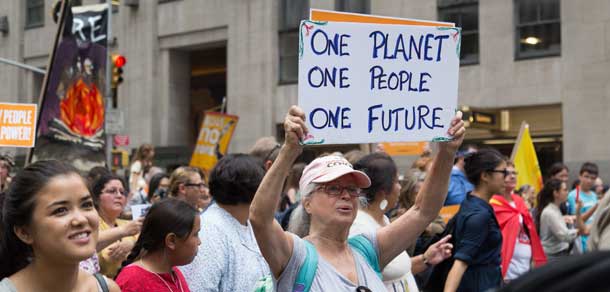SUBMITTED BY THE APEGS ENVIRONMENT AND
SUSTAINABILITY COMMITTEE
Opinions expressed do not necessarily reflect the views or policies of APEGS.
Climate change is a topic that has stirred a great deal of controversy in recent years. It has been the subject of everything from domestic political debates, international treaties and even arguments at the neighbourhood pub.
SScientists and engineers who have been studying air quality and climate have come to a conclusion about climate change: It’s real and man-made.
There is much rhetoric that surrounds this topic so it is useful to step back and review some of the evidence.
Growth in greenhouse gases
The earth’s atmosphere and climate have changed radically over geologic time. An ice core recovered from Lake Vostok, Antarctica, and other climate proxy data show that atmospheric CO2 has varied between 180 and 280 parts per million (ppm) over the past 420,000 years. Currently it is above 400 ppm and increasing at 1 to 2 ppm per year.
Increases in global air temperature in response to increases in atmospheric CO2 was first predicted by Nobel Laureate Svante Arrhenius in 1895.
The evidence does show warming, and it appears to be man-made, caused by unsustainable rates of fossil fuel consumption (see Figure 1).
FIGURE 1
Emissions Allocation: We All Have To Do Our Part
Although the evidence of climate change is daunting, the situation is far from hopeless. Engineers and geoscientists have a role to play in solving the problem.
Climate projections span a range of greenhouse gas (GHG) emissions scenarios based on assumptions about population growth, economic activity, energy intensity and socio-economic development.
The predictions show the worst effects of climate change could be avoided if atmospheric CO2 concentrations are kept below 530 ppm. This implies global emissions should be kept stable at the current 50 gigatonnes per year (Gt/yr) until 2030, dropping to 30 Gt/yr by 2050.
It’s hard to envision what that means with numbers on that scale so let’s break it down to the personal level. To reach this goal, each person’s CO2 “allowance” would have to come down to 6.8 tonnes per year (t/yr).
The average Canadian emits 21 t/yr. Here in Saskatchewan we each emit 67 t/yr.
It’s unlikely that in Saskatchewan we will reach the 6.8 t/person/year goal any time soon. In fact, we may never reach it. But we have to be aware that, if we’re not reaching that goal, there are others in the world who will have to make do with an even lower target to compensate. We need to do whatever we can to improve.
Mitigation Opportunities In Saskatchewan
To figure out how to fix Saskatchewan’s GHG emissions problem, we first need to measure it.
In 2013, Saskatchewan emitted 74.8 million tonnes of CO2 equivalents (74.8 Mt CO2e).
How did we rack up such a big CO2 “tab”?
The single biggest culprit is general energy use coming in at 59.5 Mt CO2e followed by agricultural emissions (13.0 Mt CO2e).
General energy use includes emissions from transport (16.6 Mt CO2e), public electricity and heat production (16.0 Mt CO2e) and fugitive emissions (e.g., flare gas) from oil and gas production (13.0 Mt CO2e), with other sectors registering lower amounts.
And if you drill down, there are some interesting surprises. Emissions from on-road transportation (7.8 Mt CO2e) are just about the same as the total emissions for mining and upstream oil and gas production (7.8 Mt CO2e). Commercial and institutional emissions (1.2 Mt CO2e) and residential emissions (1.9 Mt CO2e) are actually higher than those from our petroleum refineries (1.1 Mt CO2e).
This breakdown isn’t to place blame but to look for opportunities for improvement.
Transportation:
Except for increasing biofuel use, there are few opportunities for Saskatchewan residents to reduce on- and off-road emissions until electric vehicles are affordable and broadly available. Designing and planning transport with fuel economy as an objective is something that can be done today.
Agriculture:
Agricultural emissions are from soils and from livestock and their manure. Mitigation options may be limited to reducing food waste and meat consumption.
Resource Sector:
Many mines and upstream oil and gas industries are already employing best available energy technologies because they are working to improve their bottom line. In the face of historically low commodity prices, resource companies have more motivation than ever to reduce production costs. But these heavy industries are nonetheless some of the largest electricity consumers, so further efficiencies may yet be found.
Fugitive Gases:
One of the best opportunities to reduce Saskatchewan’s carbon profile is to deal with fugitive methane emissions from oil and gas production – the constant, small leaks of natural gas that escape from pipelines, valves and other equipment. Alberta and Saskatchewan are moving aggressively with policies intended to reduce fugitive methane emissions by 50 per cent. Implementing these reductions could reduce provincial emissions by nine per cent or about six t/person.
Decarbonizing the Grid:
It’s no secret that Saskatchewan’s electrical grid is the most fossil-fuel reliant of any in Canada (650 t CO2e/GWh). Some improvements can be achieved through reduced electrical demand and there have been many initiatives to this end. But the challenge of reducing the carbon intensity of our grid remains. If we could cut the carbon intensity of our grid in half, it would reduce provincial emissions by 11 per cent or by about 13 t/person.
Wind and solar photovoltaic power systems have minimal carbon profiles (11 t CO2e/GWh and 44 t CO2e/GWh respectively) and their costs continue to drop. But their low capacity factors will require backup sources. Natural gas seems attractive, but its carbon intensity (477 t CO2e/GWh) is too high to achieve long-term emissions targets.
Carbon capture utilization and storage (CCUS) is being pioneered in Saskatchewan and lowers emissions intensity for coal from about 1000 to 120 t CO2/GWh. But it’s also an expensive solution that may make it unattractive compared to other low-carbon sources, such as nuclear (10 – 20 t CO2e/GWh) and large-scale hydro (5 – 10 t CO2e/GWh).
The Challenge
The enormity of the engineering challenges required to mitigate climate change is often underestimated. As APEGS members, we hold the knowledge and skills to rise to this challenge for the benefit of Saskatchewan and the world.


